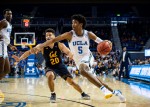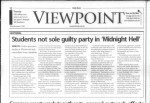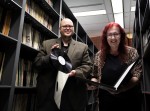UCLA and Oregon began the season as the media’s top-two choices to win the Pac-12 men’s basketball title.
To say they have not been playing like the favorites would be an understatement.
The Bruins fired coach Steve Alford after losing four straight games to close its nonconference slate. On the other hand, the Ducks’ crown jewel – top-five national recruit center Bol Bol – is out for the season, and coach Dana Altman has only eight healthy scholarship players.
The two schools will try to reverse their fortunes as UCLA (9-6, 2-0 Pac-12) embarks on its first road trip in conference play. The Bruins visit the Oregon Ducks (9-5, 0-1) on Thursday and the Oregon State Beavers (9-4, 1-0) on Sunday.
“(Oregon’s crowd) is right up there with the best of them,” said redshirt junior guard Prince Ali. “Every time I’ve played there, it’s been sold out, so that’s going to be loud.”
UCLA hasn’t fared well as visitors in recent years.
Under Alford, the Bruins had a 21-30 record in road games. Their lone road contest this season culminated in a 93-64 loss at Cincinnati in which the Bruins turned the ball over 14 times.
“Turnovers are a major, major concern,” said interim coach Murry Bartow. “Because Oregon, in their last three games, they’ve turned people over at about 18 a game. And we just had 22 in our last game.”
Over the past six games, UCLA has averaged 16.5 turnovers per contest. Only four players have more assists than turnovers this season.
“We have to care more for the possession of the ball – every possession matters, that’s how we have to treat the ball,” said sophomore guard Chris Smith. “We’re a little careless sometimes, myself especially. I have a lot of bad turnovers every game, that’s just little lapses every now and then that we have to fix.”
Something the Bruins don’t have to worry about is a size advantage inside the paint.
The 7-foot-2-inch Bol recently had season-ending surgery for a left foot fracture and Ducks forward Kenny Wooten is out for upwards of three weeks with a broken jaw.
What was billed as a duel between two five-star, 7-plus-foot freshman centers now features UCLA big man Moses Brown against an undersized Oregon frontcourt.
Brown is coming off a 17-point, 10-rebound performance against Stanford and a 16-point, 9-rebound outing versus California. He averages just over eight shots per game on 67.8 percent shooting, a mark that ranks No. 6 in the nation.
The Ducks’ tallest healthy rotation players are forwards Louis King and Paul White, who are both 6 feet, 9 inches tall.
Brown’s ability to finish in the paint and above the rim adds another dimension to UCLA’s offense in a critical area.
“Analytically, you want shots in the paint,” Bartow said. “If you can’t get shots in the paint, you want clean 3s. Anything in between there is really not a great shot.”
Balling against the Beavers
Last season, the Beavers and the Bruins split the home-and-home series. The lone yet significant departure from coach Wayne Tinkle’s roster is forward Drew Eubanks, who averaged 13.2 points and 6.8 rebounds per game.
Oregon State was picked to finish No. 10 in the conference this year, but after losing at home to Kent State, the Beavers won their Pac-12 opener against their in-state rival Saturday.
Forward Tres Tinkle leads the team with 20.5 points per game, and he has scored in double figures in each of the three games he has played against UCLA.






